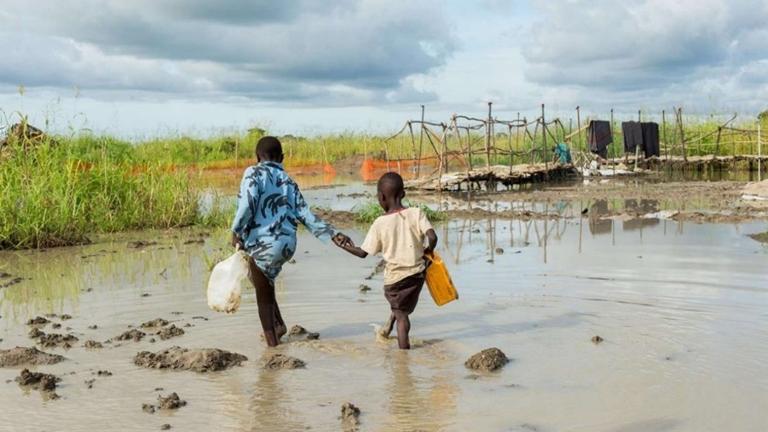During 2023 nearly every region of the world was inundated with floods. One of the most tragic incidents was a flash flood in Derna, Libya, which killed more than 4,000 and left many, many more unaccounted for. The Prevention Web editors have been testing the waters and sounding the depths of news, views and findings about floods, to bring you the latest updates and cutting-edge research. Here we offer you some of the key learnings we picked up about floods in 2023: four new facts about flood risks, and four innovative promising solutions.

Four findings on flood risks
1.Global warming will intensify heavy rain more than expected
Analysis by researchers from the Potsdam Institute of Climate Impact Research (PIK) shows that state-of-the-art climate models significantly underestimate how much extreme rainfall increases under global warming – meaning that extreme rainfall could increase quicker than climate models suggest.
2.How floods kill, long after the water has gone
A study led by Monash University scientists in Australia has found that people impacted by a flooding event are at significantly increased risk of dying – including heart and lung problems – in a crucial window between three and six weeks after the event, even after the flooding has dissipated.
The study, published today in the BMJ, found that the risk of dying increased and persisted for up to 60 days (50 days for cardiovascular mortality) after a flooded day - increasing by for 2.1% for all-cause deaths, 2.6% for cardiovascular deaths, and 4.9% for respiratory deaths.
3.Fleeing drought, vulnerable populations face flood risk in most African countries
In 80% of African countries, people moved toward rivers and into cities during drought, increasing the number of people living in flood-risk areas in recent decades, according to a new study. This resettlement pattern will likely intensify in coming decades as climate change is expected to make droughts more frequent and severe.
4.New research reveals global dangers of glacial flooding
A new study identifying regions around the world where people are most at risk from flooding caused by melting glaciers could help save vulnerable lives.
The Himalayas have been a popular subject for research, accounting for 36% of glacial outburst flooding studies carried out between 2017 and 2021. But Dr Robinson says the Andes has a similar level of danger and is far less well-studied.
“Since 1990, the number of glacial lakes in the region increased by 93% compared to 37% in High Mountains Asia, and as a nation, Peru, has the third highest danger of glacial lake outburst flooding globally.
Four promising flood solutions
1.Looking beyond national borders would improve preparedness for extreme floods
A team of European scientists, including experts at the UK Centre for Ecology & Hydrology (UKCEH), analysed river discharges – the volume of water flowing through a channel per second - from 8,000 gauging stations across Europe from 1810–2021 to identify historic megafloods.
They found 95.5% of megafloods could have been anticipated based on previous events at locations elsewhere in the continent with similar climate and variability in terms of how much water that rivers discharge in response to factors such as rainfall and temperature.
2.Beaver-like dams can enhance existing flood management strategies for at-risk communities
River barriers made up of natural materials like trees, branches, logs and leaves can reduce flooding in at-risk communities by storing water upstream, new research has found.
The study, led by scientists from Cardiff University and the University of Worcester, assessed the impact of leaky barriers at a natural flood management site on a small Shropshire river over a period of two years.
Human-made leaky barriers, which are designed to imitate beaver dams, work in units of 50-100, deliberately raising water levels upstream to slow down river flow through storage and diversion, providing ecological benefits to the river corridor and on nearby farmland.
3.Flash floods can be forecast an hour in advance
Researchers at the Korea Institute of Civil Engineering and Building Technology (KICT) have developed a system that can forecast flash floods one hour in advance.
The flash flood forecasting system extracts local factors that determine the depth of flooding and the extent of flood damage in different regions and conditions based on the information about the damage from previous floods and specific characteristics of regional floods. With these, the system derives its own equations of the characteristics and uses them to predict the risks of flash floods in areas that do not have any flood damage information.
4.What the UK’s emergency mobile broadcast tests can teach us about flood warnings
Crucially, using cell broadcast means that warnings can now be targeted at specific places that will be affected by a hazard, which will help save lives and reduce harm. As climate change increases the frequency and magnitude of extreme weather events, this is especially important. This is good news for the UK: it will now have a robust, reliable and secure way of communicating with citizens.
Sources:
UNDRR
https://www.preventionweb.net/news/what-we-learned-about-floods-2023 .
Provided by the IKCEST Disaster Risk Reduction Knowledge Service System
Comment list ( 0 )
